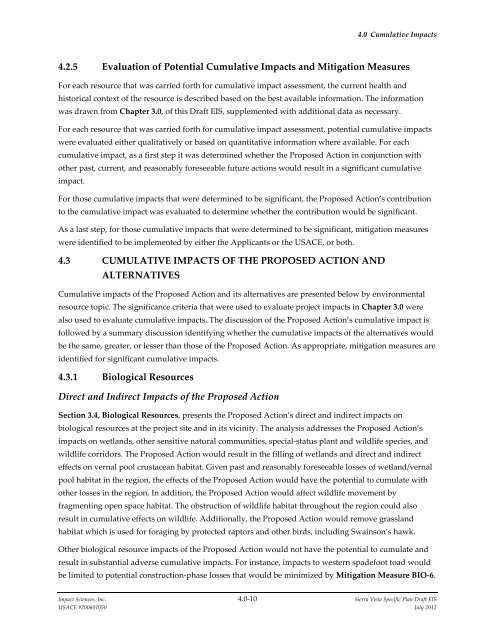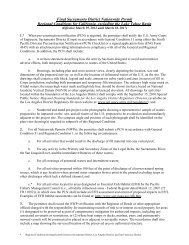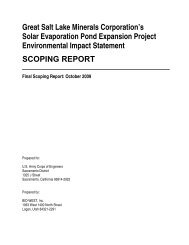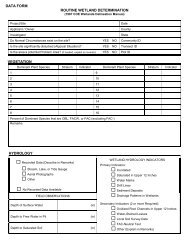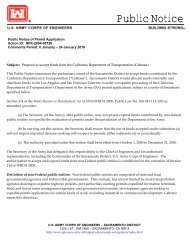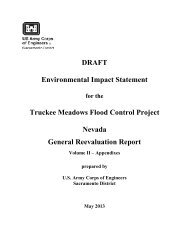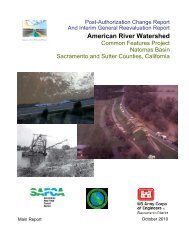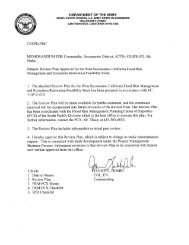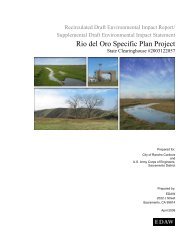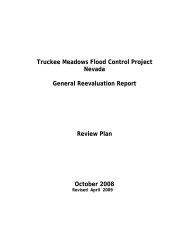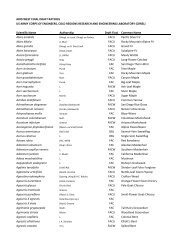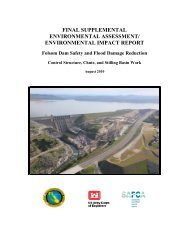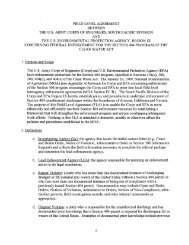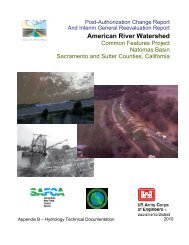4.0 CUMULATIVE IMPACTS - Sacramento District - U.S. Army
4.0 CUMULATIVE IMPACTS - Sacramento District - U.S. Army
4.0 CUMULATIVE IMPACTS - Sacramento District - U.S. Army
You also want an ePaper? Increase the reach of your titles
YUMPU automatically turns print PDFs into web optimized ePapers that Google loves.
<strong>4.0</strong> Cumulative Impacts<br />
4.2.5 Evaluation of Potential Cumulative Impacts and Mitigation Measures<br />
For each resource that was carried forth for cumulative impact assessment, the current health and<br />
historical context of the resource is described based on the best available information. The information<br />
was drawn from Chapter 3.0, of this Draft EIS, supplemented with additional data as necessary.<br />
For each resource that was carried forth for cumulative impact assessment, potential cumulative impacts<br />
were evaluated either qualitatively or based on quantitative information where available. For each<br />
cumulative impact, as a first step it was determined whether the Proposed Action in conjunction with<br />
other past, current, and reasonably foreseeable future actions would result in a significant cumulative<br />
impact.<br />
For those cumulative impacts that were determined to be significant, the Proposed Action’s contribution<br />
to the cumulative impact was evaluated to determine whether the contribution would be significant.<br />
As a last step, for those cumulative impacts that were determined to be significant, mitigation measures<br />
were identified to be implemented by either the Applicants or the USACE, or both.<br />
4.3 <strong>CUMULATIVE</strong> <strong>IMPACTS</strong> OF THE PROPOSED ACTION AND<br />
ALTERNATIVES<br />
Cumulative impacts of the Proposed Action and its alternatives are presented below by environmental<br />
resource topic. The significance criteria that were used to evaluate project impacts in Chapter 3.0 were<br />
also used to evaluate cumulative impacts. The discussion of the Proposed Action’s cumulative impact is<br />
followed by a summary discussion identifying whether the cumulative impacts of the alternatives would<br />
be the same, greater, or lesser than those of the Proposed Action. As appropriate, mitigation measures are<br />
identified for significant cumulative impacts.<br />
4.3.1 Biological Resources<br />
Direct and Indirect Impacts of the Proposed Action<br />
Section 3.4, Biological Resources, presents the Proposed Action’s direct and indirect impacts on<br />
biological resources at the project site and in its vicinity. The analysis addresses the Proposed Action’s<br />
impacts on wetlands, other sensitive natural communities, special-status plant and wildlife species, and<br />
wildlife corridors. The Proposed Action would result in the filling of wetlands and direct and indirect<br />
effects on vernal pool crustacean habitat. Given past and reasonably foreseeable losses of wetland/vernal<br />
pool habitat in the region, the effects of the Proposed Action would have the potential to cumulate with<br />
other losses in the region. In addition, the Proposed Action would affect wildlife movement by<br />
fragmenting open space habitat. The obstruction of wildlife habitat throughout the region could also<br />
result in cumulative effects on wildlife. Additionally, the Proposed Action would remove grassland<br />
habitat which is used for foraging by protected raptors and other birds, including Swainson’s hawk.<br />
Other biological resource impacts of the Proposed Action would not have the potential to cumulate and<br />
result in substantial adverse cumulative impacts. For instance, impacts to western spadefoot toad would<br />
be limited to potential construction-phase losses that would be minimized by Mitigation Measure BIO-6.<br />
Impact Sciences, Inc. <strong>4.0</strong>-10 Sierra Vista Specific Plan Draft EIS<br />
USACE #200601050 July 2012


